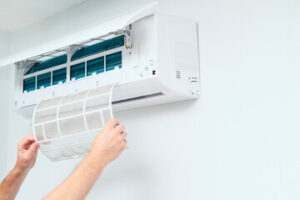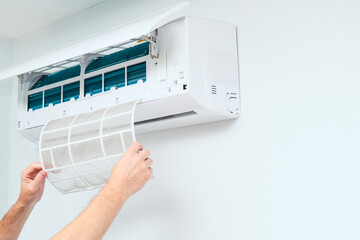Air duct cleaning is a professional service that should be performed when there are allergens in the home, especially those related to pets or smoking. It is also recommended after construction or remodeling projects where construction dust and debris can enter ducts.
Air Duct Cleaning Utah will vacuum each vent individually while applying negative pressure. They will use rotating brushes and compressed agitation air-whipping tools to dislodge settled dust.

When air ducts get clogged with dust, dirt, pollen, pet dander, viruses, bacteria, and mold spores, they circulate these allergens around the house. This can trigger allergic reactions in sensitive individuals. Fortunately, regular air duct cleaning can significantly reduce the number of allergens in your home.
Dust allergies are a common problem that affects many homes. Although regular sweeping and dusting can help, it is very difficult to eliminate the dust that constantly builds up on surfaces. This dust is blown from the air vents and spreads throughout your home with each heating and cooling cycle. If you have dust allergies and notice a build-up of dust in your home, it’s likely that your ductwork is overdue for cleaning.
Other types of allergy-causing contaminants that often find their way into air ducts include pollen, pet dander, smoke particles, and mold. These substances are found in the atmosphere, but they can also enter your home through open windows and doors or on clothing and shoes. Eventually, these allergens settle in air ducts and are blown out through the vents as the HVAC system operates.
Over time, these allergens can accumulate to a considerable amount, and the passing air picks them up and recirculates them in your home. This aggravates your allergies and asthma symptoms, and it can lead to breathing problems and other health issues.
Considering the fact that allergens like dust mites, cockroaches, mold, and pollen can grow in humid environments, your ductwork is an ideal place for them to take root. If you notice any signs of mold in your ductwork, it’s important to call for professional cleaning right away.
During the process of air duct cleaning, a certified technician will inspect your ducts and determine their condition. He or she will then protect your furniture, floors, and belongings by laying down drop cloths and sealing off registers. Next, he or she will use negative air pressure and powerful vacuuming to remove the pollutants from your air ducts and restore clean indoor air quality. The process usually takes about three hours to complete and is safe for most homes and businesses.
Dust contains fine particulate contaminates like dirt, pet dander, human hair and dead skin. It also contains microorganisms like bacteria, fungi and rodent feces. When left to circulate in a home, these contaminants can contribute to respiratory complications like itchy eyes, nose and throat, sneezing, sinus congestion and difficulty breathing.
When duct cleaning companies use compressed air systems to clean your ducts, they blow out the contaminated air with a vacuum-like hose. This can lead to releasing contaminants into the living space of your home, especially if the company uses an ineffective system or is unprofessional.
A professional duct cleaning service will use a truck-powered, HEPA-approved vacuum system to clean your ductwork. The technician will connect the ductwork to a vacuum, then insert cleaning tools into the vents to dislodge the debris. They will then use the vacuum to suck the particles away and into the truck-mounted filtration system.
Duct cleaning can be beneficial if your ducts are clogged with dust or if there are signs of mold growth in your home’s ductwork. It can also be helpful if you have allergies that are aggravated by the indoor air in your home. However, it’s important to note that the EPA doesn’t recommend getting your ducts cleaned on any specific schedule.
Some duct cleaners may suggest that you allow them to apply chemical biocides or sealants to the inside of your ductwork and other components in your home’s HVAC system as a means of killing bacteria and preventing future biological growth. These methods have not been thoroughly researched and should be avoided. Unless you have been diagnosed with a mold-related health condition, there is no evidence that these chemicals will improve your indoor air quality or prevent the return of mold growth in the future. The same can be said for duct liners, which are often used to encapsulate the inside surfaces of ductwork and equipment. They can lead to a build-up of moisture, which can exacerbate mold growth and create a breeding ground for bacteria. Using liners should only be considered after you’ve had your ducts thoroughly cleaned of all visible contamination.
Insects can get into the air ducts and cause problems just as they can in other parts of your home. Rodents and insects leave urine, feces, contaminated food and hair, diseases, debris and other contaminants in your ducts, which can be circulated throughout the entire house. If you have a family member who has severe allergies or asthma, these pollutants can trigger attacks. Regular cleaning of your air ducts helps remove insect nests and limit future infestations.
Rodents can use duct work as a highway to all parts of the building or home, and mice especially are known to rip up insulation to make their nests. These rodents also contaminate the air with their droppings, urine and disease-causing bacteria on their feet and legs. Cleaning your air ducts can reduce the presence of these pests in the house, but it’s also a good idea to keep food inside containers and not on countertops or table surfaces, and fix any cracks or holes in windows and doors.
Cockroaches can squeeze into the smallest cracks and crevices and may invade a ductwork or vent. They carry salmonella on their slender bodies and can cause serious illness in sensitive people. They can also contaminate foods with their feces, saliva and body parts. A professional extermination can help solve a cockroach infestation, but it’s important to clean frequently and keep up with maintenance for the best results.
Spiders can also wriggle into small spaces and infest vents, ductwork and indoor air conditioning units. They don’t cause as much damage as roaches, but their bites are painful and some spiders are poisonous. They can also contaminate the air with their webs and droppings. Regularly cleaning and maintaining your ductwork and other components of your HVAC system can keep spiders away, but you should also call in a specialist to do this regularly.
Other pests that can infest your ductwork include ants, flies, fleas, bees and wasps. You should look for their signs of activity, such as dust accumulation and webs on the vents, ductwork and other components of your HVAC systems.
Mold is a type of fungi that can cause serious problems when it infiltrates homes and businesses. It produces thousands of different species of spores that can cause a wide range of health issues. Mold spores spread through the air and can also settle on porous surfaces such as walls, carpeting, and furniture. Mold spores release toxic gases such as volatile organic compounds (VOCs) that can irritate the lungs, nose, and throat. These toxins are especially dangerous for people with allergies, respiratory conditions, or weakened immune systems.
The most common signs that your HVAC system is harboring mold include noticing patches of green, black, or white on vent covers. Moldy odors are another sign of a problem. These odors are produced when the fungus releases spores that can trigger allergic reactions. If you notice these odors, you should schedule an HVAC mold inspection.
You can try to remove mild cases of mold in your air ducts by scrubbing the affected areas with a brush and a rag soaked in hot water. However, this method isn’t foolproof, as mold spores may still be hiding inside nooks and crannies of your home or business.
A professional air duct cleaning service will ensure that every part of your air ducts is cleaned, including hidden areas. A quality duct cleaning service should also make sure that all access holes used to clean your air ducts are properly closed once the cleaning is complete.
If you are concerned about a possible mold problem in your air ducts, contact to schedule an inspection and cleaning appointment. A qualified technician will inspect your air ducts, clean any visible traces of mold, and check the entire HVAC system for signs of additional issues such as a leaky pipe or rotted insulation. Then they will ensure that all access holes are sealed. This will help prevent future mold and spores from invading your air supply.

